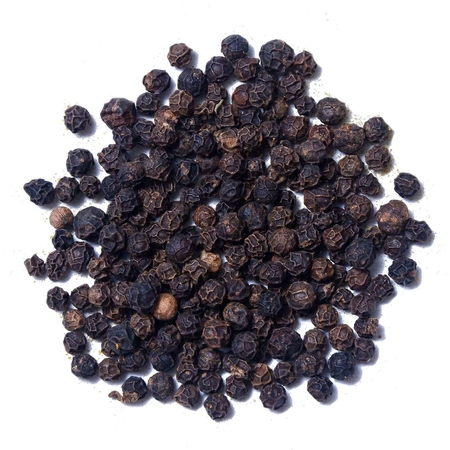





Botanical name Piper nigrum L.
INCI Name Piper nigrum (Black Pepper) Oil
Family Piperaceae
Source Seed/Fruit
Description / Color / Consistency Colourless or light coloured clear mobile liquid with spicy woody odor.
Aromatic Summary / Note / Strength of Aroma Crisp, fresh, peppercorn aroma.
Blends With Peppermint, Clove, Wintergreen, Basil, Bergamot, Cinnamon, Lemon.
Product Abstract
Black pepper is native to India and is extensively cultivated there and in tropical regions. The spiciness of black pepper is due to the chemical piperine. black pepper essential oil and its major active principle, piperine, which has the ability to enhance the digestive system and protect us against oxidative damage. The aroma of black pepper is spicy, musky, warm, and or course peppery. Its oil is mostly used as a supplement for digestive and nervous system support and wellness. For this reason many people will use the oil as a flavoring in their cooking, just as you might with crushed black pepper.
History
Pepper is native to South Asia and Southeast Asia and has been known to Indian cooking since at least 2000 BCE. J. Innes Miller notes that while pepper was grown in southern Thailand and in Malaysia, its most important source was India, particularly the Malabar Coast, in what is now the state of Kerala. The lost ancient port city of Muziris in Kerala, famous for exporting black pepper and various other spices, gets mentioned in a number of classical historical sources
Common Usage
Production and Trade
As of 2013, Vietnam was the world's largest producer and exporter of black peppercorns, producing 163,000 tonnes or 34% of the world total of 473,000 tonnes. Other major producers include Indonesia (19%), India (11%) and Brazil (9%) (table). Global pepper production may vary annually according to crop management, disease and weather.Vietnam dominates the export market, using almost none of its production domestically. Peppercorns are among the most widely traded spice in the world, accounting for 20 percent of all spice imports
Cautions
Pepper may cause sneezing. Patients who have undergone abdominal surgery should not add excessive pepper to their diet because it can have an irritating effect on the intestines. Black pepper should not be taken in high concentration, and if you see signs of an allergic reaction, discontinue its use and consult a doctor.
Key constituents
b-Caryophyllene 9.4–30.9%
(þ)-Limonene 16.4–24.4%
a-Pinene 1.1–16.2%
b-Pinene 4.9–14.3%
Sabinene 0.1–13.8%
b-Bisabolene 0.1–5.2%
a-Copaene 0.1–3.9%
(E)-b-Farnesene tr–3.3%
a-Cubebene 0.2–1.6%
d-3-Carene tr–15.5%
Safety summary
Hazards Skin sensitization if oxidized.
Cautions Old or oxidized oils should be avoided.
Our safety advice
Because of its combined (þ)-limonene, a-pinene and d-3-carenecontent we recommend that oxidation of black pepper oil is avoided by storage in a dark, airtight container in a refrigerator. The addition of an antioxidant to preparations containing it is recommended.
Regulatory guidelines
Has GRAS status. IFRA recommends that essential oils rich in limonene should only be used when the level of peroxides is kept to the lowest practical level, for instance by adding antioxidants at the time of production.
Organ-specific effects
Adverse skin reactions Undiluted black pepper oil was moderately irritating to rabbits, but was not irritating to mice or pigs; tested at 4% on 25 volunteers it was neither irritating nor sensitizing. Autoxidation products of (þ)-limonene, a-pinene and d-3-carene can cause skin sensitization. Antioxidant properties have been reported for black pepper oil. Low-level phototoxic effects reported for black pepper oil are not considered significant.
Systemic effects
Acute toxicity Non-toxic. Black pepper oil acute oral LD50 in rats >5 g/kg; acute dermal LD50 in rabbits >5 g/kg.
Carcinogenic/anticarcinogenic potential
Black pepper oil dose-dependently inhibited aflatoxin B1-induced adducts in calf thymus DNA, in the presence of rat liver microsomes. Black pepper oil showed moderate chemopreventive activity against human mouth epidermal carcinoma cells and mouse leukemia cells, with respective IC50 values of 0.215 and 0.201 mg/mL. The oil contains no known carcinogens. b-Caryophyllene and (þ)- limonene display anticarcinogenic activity.
Comments
Because of the pungency of fresh pepper, it is often incorrectly assumed that the oil must be a strong skin irritant. It is not unusual for a substance to have both antioxidant and prooxidant properties.